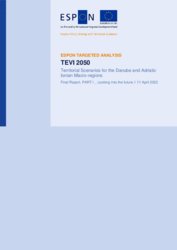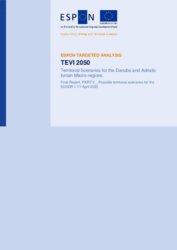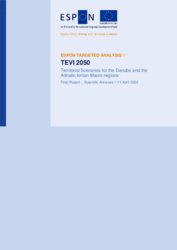TEVI2050 - Territorial Scenarios for the Danube and Adriatic Ionian Macro-regions
Theme: Territorial cooperation; territorial governance, territorial indicators and monitoring
Scope
The four EU macro-regional strategies (EUSBSR, EUSDR, EUSAIR and EUSALP) provide an integrated framework to address common challenges for the Member States and third countries located in the respective geographical areas. The strengthened cooperation is expected to benefit the economic, social and territorial cohesion.
This service contract is focused on: (1) the Adriatic and Ionian Region and (2) the Danube Region. In both macro-regions disparities and diversities within and between their member countries (the EU member states, the EIU candidate countries and EU neighbour countries); present clear challenges to achieving goals of the Strategies.
The EU Strategy for the Adriatic and Ionian Region (EUSAIR) partially overlaps with the EU Strategy for the Danube Region (EUSDR), which was established a few years earlier. This inequality in maturity of governance structure and stock of analyses can potentially play an important role in exploiting synergies between the two macro-regions in light of the pursued goals of a better territorial integration and cohesion in a wider geographical area than just one specific macro-region.
The objective of this activity is to develop territorial scenarios for the EUSDR and EUSAIR as the means to enhance the territorial dimension of the respective EU Strategies and to embed the territorial evidence in policymaking at relevant levels of the countries involved in their implementation.
Main outcomes
- Identification of the main processes, factors, obstacles and drivers that will shape the territorial development and spatial integration of the Danube Region and the Adriatic and Ionian Region in 2050. The common challenges identified in the strategic documents for each macro-region (e.g. demography, energy issues, mobility, connectivity, digitalization, innovation and climate change) shall be taken into consideration.
- Identification of synergies and conflicts between the above-mentioned factors, obstacles and drivers (in particular, from the perspective of the key policy processes).
- Formulation of baseline territorial development scenarios for the Danube Region and for the Adriatic and Ionian Region for 2050.
- Production of alternative territorial development scenarios for the Danube Region and for the Adriatic and Ionian Region through a participatory dialogue with the steering committee and possibly involving other stakeholders.
- Development of policy recommendations on possible policy pathways i.e. policy actions requiring joint attention of the EUDSR and EUSAIR governance bodies and other levels of governance in the respective EU macro-regions in order to steer the development towards the chosen scenarios. In this case, soft cooperation and multi-level governance actions shall be taken into consideration.
Contractors
- Spatial Foresight GmbH, LU
- Centre for Urban and Territorial Development (CDUT), RO
- Institute for Spatial Policies (IPoP), SL
Budget
€ 127,775.00
Lifetime
April 2021 – May 2022
Deliveries
- Inception delivery, 14 June 2021
- Interim delivery, 13 September 2021
- Final delivery, 11 April 2022
Contact
Sandra Di Biaggio (Senior Project Expert) [email protected]; Stefania Rigillo (Financial Expert) [email protected]



